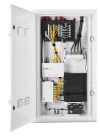Hey everybody. Name here is John.
I'm preparing to install my first security camera sys. Have a 16ch NVR on the way and trying to imagine how I'm going to bring 16 cables thru the interior wall in my media room and make it look right.
Wondering if I can install a PoE switch in the attic and just run 1 cable down thru the interior wall. Attic gets pretty hot and A/C power isn't near-by.
Thx!
I'm preparing to install my first security camera sys. Have a 16ch NVR on the way and trying to imagine how I'm going to bring 16 cables thru the interior wall in my media room and make it look right.
Wondering if I can install a PoE switch in the attic and just run 1 cable down thru the interior wall. Attic gets pretty hot and A/C power isn't near-by.
Thx!



